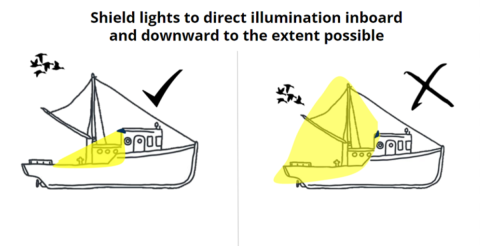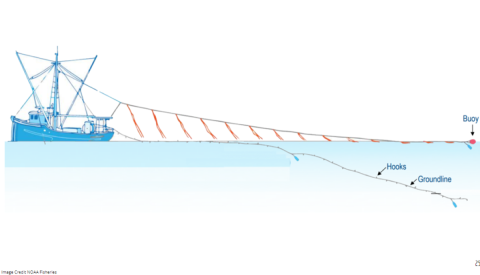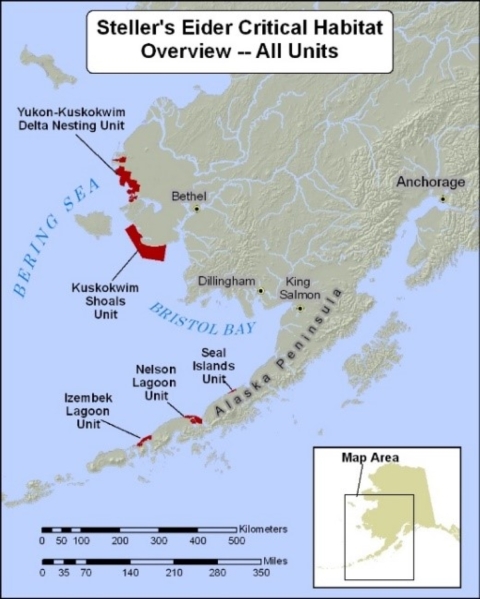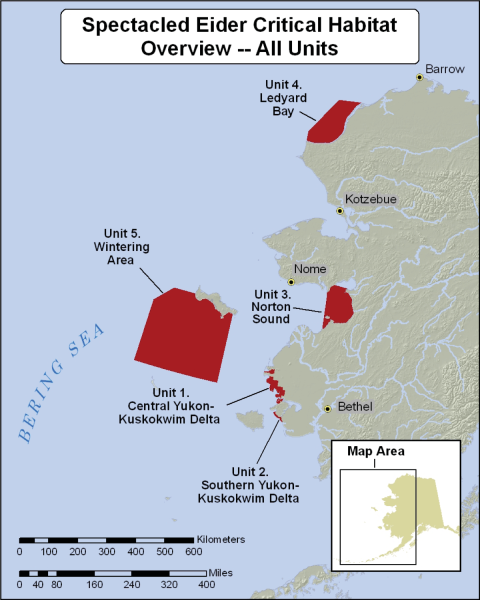The U.S. Fish and Wildlife Service provides technical assistance to help reduce human vessel interactions with avian species listed under U.S. Endangered Species Act and the Migratory Bird Treaty Act.
Birds flying in the marine environment are not expecting to encounter vertical structures over water. Collisions with vessels, gear, and other vertical structures generally involve one or two birds, but "bird storms" have occurred where various species of seabirds have struck vessels at sea.
Vessels traveling during fall and spring bird migration seasons or near bird concentration areas have a higher risk of collisions.
The following factors increase the risk of bird/vessel collisions
• vessel lighting (may confuse and can even attract birds)
• impaired visibility (at night or during inclement weather)
• vessel gear (gear that may not be visible to birds, such as lines, masts, and towing equipment)
• seasonal timing (during bird migration and molt)
There are two threatened and one endangered avian species that vessels may encounter while traveling in waters surrounding Alaska: Steller’s eider (T), spectacled eider (T), and short-tailed albatross (E). The U.S. Fish and Wildlife Service provides the following guidance to minimize human encounters with these birds as well as other migratory birds in Alaskan waters.
Guidance for minimizing bird-vessel collisions
Steller's Eiders and Spectacled Eiders
ESA-listed eiders are at risk of colliding with moving or stationary marine vessels around Alaska. Eiders typically fly in groups, low over the water (approximately 32 feet or lower) and at relatively high speeds (up to approximately 45 miles per hour). Although we expect most migrating eiders to respond to vessel presence by moving away from the vessel, impaired visibility and vessel lighting configurations may disorient and/or attract birds to vessels. Additionally, molting birds are not able to fly and may have trouble moving quickly away from vessels.
Impaired visibility
When visibility is impaired, such as at night or during periods of increased fog or cloud cover, eiders may be more likely to collide with vessels. Additionally, during high wind or rain/snow, eiders may attempt to land on vessels to seek refuge from bad weather.
Vessel lighting
Certain vessel lighting configurations may increase attraction, disorientation, and collision risk for eiders and other birds. There is also evidence that red steady-state lights are particularly attractive and disorienting to birds. During hours of darkness when vessels are lighted, eiders may be particularly vulnerable to collision risk.
Short-tailed Albatross
Short-tailed albatross are often solitary, and typically maintain a soaring flight pattern which may help to reduce the risk of colliding with vessels. However, in search of food, or due to curiosity, albatross may be particularly attracted to fishing vessels, where they are vulnerable to bycatch through hooking or entanglement with gear.
Avoidance Measures
Vessel lighting
When operating after dark, vessels should implement the following measures to the maximum extent practicable, except when doing so would pose a risk to health and safety.
To reduce light attraction to birds, the U.S. Fish and Wildlife Service recommends that:
• Mariners attempt to keep deck lighting to a minimum, and shield lights to direct illumination inboard and downward to the extent possible while still maintaining compliance with navigation rules.
• If red lighting is used, those lights be limited to interior spaces, and windows should be shaded to the extent practicable when indoor spaces must be lit at night.
It is the U.S. Fish and Wildlife Service’s intent that mariners be cognizant of these recommendations, although we recognize that they may not always be suitable or practicable to implement.
Vessel Gear
When operating with lines (such as fishing lines, gear tethers, or other forms of elevated lines connected to the vessel that are then submerged in the marine environment), the following measures should be implemented to the maximum extent practicable.
• Use of streamers/tori lines to deter birds from striking lines or being caught by fishing gear.
• Bird bafflers to reduce the risk of strikes.
• Weighted hooks to reduce the risk of bycatch.
• Increase set-net visibility to extent practicable or set nets at night when many birds reduce foraging to reduce the risk of bycatch.
• Strive to use lead-free fishing tackle and net weights to reduce the risk of environmental contaminants.
Seasonal timing
Concern for eider-vessel collision risk is particularly high between August and November, during which time Steller’s and spectacled eiders frequently fly in large groups between nesting, molting, and wintering areas. This timing coincides with decreasing hours of daylight and a high potential for inclement weather, both of which may impair eider visibility to human observers and increase the likelihood that birds may become disoriented by ship lighting, in turn, reducing their ability to avoid colliding with structures.
Additionally, areas have been designated as critical habitat for both spectacled and Steller’s eiders. These areas represent locations that are of particular importance to each species and/or locations at which birds are particularly vulnerable to disturbance. For example, critical habitat for spectacled eiders has been designed in Ledyard Bay and Norton Sound for molting, where large numbers of birds congregate to feed and replace their feathers; the Yukon-Kuskokwim Delta for nesting, where many birds raise young; and south of Saint Lawrence Island, where, for decades, the world population of spectacled eiders has congregated for the winter.
We ask that mariners are cognizant of the importance of these locations to each species; we ask that vessels limit their transit and actions (research, fishing, etc.) within these areas and be extra cautious about vessel lighting. Furthermore, we ask that marines do not disturb congregations of eiders within these areas as they may be flightless and unable to move away from vessels.




